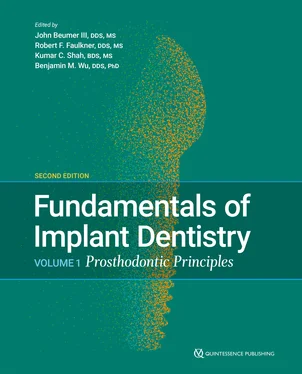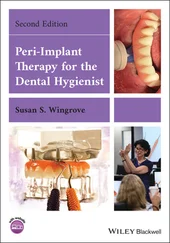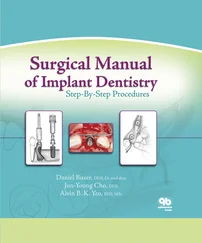145.Mano SS, Kanehira K, Taniguchi A. Comparison of cellular uptake and inflammatory response via toll-like receptor 4 to lipopolysaccharide and titanium dioxide nanoparticles. Int J Mol Sci 2013; 14:13154–13170.
146.Okuda-Shimazaki J, Takaku S, Kanehira K, Sonezaki S, Taniguchi A. Effects of titanium dioxide nanoparticle aggregate size on gene expression. Int J Mol Sci 2010;11:2383–2392.
147.Triplett RG, Frohberg U, Sykaras N, Woody RD. Implant materials, design, and surface topographies: Their influence on osseointegration of dental implants. J Long Term Eff Med Implants 2003;13:485–501.
CHAPTER 3
Implant Biomechanics, Screw Mechanics, and Occlusal Concepts for Implant Patients
Benjamin M. Wu | Jaafar Abduo | Karl M. Lyons | Donald R. Schwass Kumar C. Shah | Pravej Serichetaphongse | Robert F. Faulkner
An important goal of prosthodontic rehabilitation is the long-term stability of restorations, supporting structures (eg, tooth, implants, bone, soft tissues), muscles of mastication, temporomandibular joints (TMJs), and the neuromuscular control system during normal function and anticipated occlusal changes. These natural tissues and artificial materials can change over time due to biologic (eg, aging, disease), biochemical (eg, drugs, lifestyle, oral habits), and biomechanical factors. This chapter focuses on the role of biomechanics by considering the action (occlusion, parafunction) and reaction (design parameters) to forces and summarizes relevant clinical considerations that promote long-term success.
Occlusal Forces: Actions and Reactions
Functional and parafunctional occlusal forces and moments (moment = force × distance) result in cyclic stress (stress = force / area) and strain (strain = deformed length / original length) within the prosthetic materials, implant components, and surrounding natural tissues. For natural biomaterials such as bone and soft tissues, the strain magnitudes, frequency, and duty cycle act cooperatively with the local biochemical signals to mediate biologic processes ranging from atrophy, necrosis, resorption, maintenance, remodeling, regeneration, and fracture depending on the load conditions. For artificial biomaterials such as polymers, metals, ceramics, and composites, the stress magnitudes will influence the material deformation, wear, creep, stress relaxation, and fatigue failure. Because stress is induced by occlusal forces, the magnitude of forces will be discussed first.
Magnitude: Maximum and nominal functional occlusal forces
The maximum biting forces that human masticatory muscles can generate depends on the force detection method, muscle mass, vertical dimension, distance from the TMJ fulcrum, periodontal support, health status of the TMJs, occlusal arrangement, age, gender, restoration type, and loading symmetry (bilateral vs unilateral). Given the wide range of variables, it is not surprising that the maximum biting forces for naturally dentate patients have been reported to range from 100 N to 1,700 N over many studies. In general, fully dentate patients generate greater maximum forces than partially dentate patients. Higher occlusal forces are typically observed more in the posterior and medial directions than in the anterior and lateral directions. For partially dentate patients, dental implants generally increase bite force, improve masticatory efficiency, and lead to overall higher patient satisfaction when compared to the partially edentulous state. For completely edentulous patients, implant-assisted overdentures exert greater maximum forces (~170 N) than those with root- supported overdentures (130 N) and conventional dentures (100 N). 1
Force measurement depends on the technology used for force recording. Numerous devices such as Black’s gnathodynamometers, strain gauges, semiconductors, strain-sensitive films (piezoelectric and polymer), pressure-sensitive foils, and microprocessor devices have been used with varying degrees of measurement errors and measurement ranges (sensitivity). Also, some of these devices (eg, mechanical dynamometers) require higher vertical jaw separation than others (eg, films), thus the measurements are made with different condylar orientation, skeletal muscle length, contraction velocity, and other factors that can alter force generation. 2These differences are not easily discerned given the large variability in human bite force, and needs have yet to be met for an accurate force recorder that can measure forces at a single-tooth level under a variety of controlled loading conditions and for a system to reproducibly generate the clinical loads.
While maximum voluntary biting force may serve as a potential indicator of masticatory system health, such maximum forces do not predict masticatory efficiency. In fact, maximum forces are typically not the culprit for the common clinically observed material failures. Besides occlusal overload during parafunction, most components fail due to time- dependent processes that occur at lower masticatory loads over millions of chewing cycles. Most healthy vertebrates can masticate involuntarily. Similar to the muscles involved in crucial cyclic movements such as breathing, walking, and gastric motility, the muscles of mastication are controlled by a central pattern generator (CPG) in the brain stem. 3Each CPG contains a group of specialized neurons that receives both sensory and reflex feedback to modulate its basal rhythmic, oscillatory electrical patterns. This phase, amplitude, and frequency of the CPG basal pattern modulates the contraction and relaxation of the masticatory muscles. The net biting force is summed by adding the corresponding resolved force vectors from all muscles of mastication. CPGs operate effectively in the absence of voluntary muscle movement and can be further influenced by external stimuli and voluntary muscle commands. Hence, more emphasis is needed on material selection and design that can prevent the cumulative damage that occurs over millions of functional loading cycles.
The CPG-generated cyclic functional forces are typically 25% to 40% of maximum loads for each individual, with greater forces at the molars and less in the incisors due to the mechanical lever system. Fully dentate patients with complete dentition or implants generate higher cyclic functional forces (~130–150 N) than edentulous patients with implant- supported overdentures (~70 N), root-supported overdentures (60 N), and conventional dentures (~40 N). 1However, the implant overdenture group produced the lowest chewing efficiency, and this difference has been attributed to the implant-related attenuation of sensory feedback to the CPG. Note that the actual forces depend on distance from the muscle and TMJ fulcrum. The human mandible acts as a third-class lever when the food is anterior to the anterior border of the masseter muscles (premolars to incisors) and behaves as a second-class lever when food is posterior to the center of mass of the masseters (molars). Therefore, under the same applied biting force, the mechanical load at the molar can easily double the apparent load at the incisor.
Direction: Axial and nonaxial loading
Forces are vectors. Moments due to a force acting on a point from a distance are axial vectors . Forces and moments acting on implants result in stress and strain throughout the supporting structures. Individual implants osseointegrated in bone can deform or move along directions that are combinations of six basic motions (or six degrees of freedom) around the implant-abutment complex’s center of mass ( Fig 3-1): three translational (linear up/down, left/right, forward/backward) and three rotational (yaw, pitch, roll). In the geometric context, pure translational movements occur when every infinitesimal point within an object moves the same distance. By that definition, translation can only occur when an object moves without rotation, tipping, bending, changing shape, or changing size. Conversely, pure rotations occur when all infinitesimal points within an object rotate around an axis of rotation, except those points that lie along the axis. In practice, most intraoral movements are comprised of components of translation and rotation.
Читать дальше












